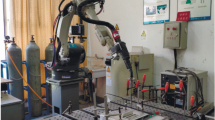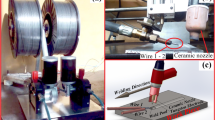Abstract
The effects of the most important process-adjusting variables (welding current and welding speed) and the percentage of the combination of TiO2 and SiO2 activating fluxes on the most important quality characteristics (weld bead width, depth of penetration, and aspect ratio of these parameters) in welding of AISI316L austenite stainless steel parts are considered. Artificial neural networks (ANN) are used to determine the relations between the input variables and output responses of the activated tungsten inert gas (A-TIG) welding process. To determine the proper ANN architecture (the proper number of hidden layers and their corresponding neurons/nodes), the particle swarm optimization (PSO) method is used. Experimental tests are conducted to evaluate the proposed procedure performance. Based on the results, the proposed method is found to be efficient in modeling and optimization of the A-TIG welding process.





Similar content being viewed by others

REFERENCES
R. S. Vidyarthy, A. Kulkarni, and D. K. Dwivedi, “Study of Microstructure and Mechanical Property Relationships of A-TIG Welded P91-316L Dissimilar Steel Joint," Materials Sci. Engng. A 695 (5), 249–257 (2017).
K. D. Ramkumar, V. Varma, M. Prasad, and N. D. Rajan, “Effect of Activated Flux on Penetration Depth, Microstructure and Mechanical Properties of Ti-6Al-4V TIG Welds," J. Materials Process. Technol. 261 (5), 233–241 (2018).
Y. Zou, R. Ueji, and H. Fujii, “Mechanical Properties of Advanced Active-TIG Welded Duplex Stainless Steel and Ferrite Steel," Materials Sci. Engng. A 620 (6), 140–148 (2015).
A. Kulkarni, D. K. Dwivedi, and M. Vasudevan, “Dissimilar Metal Welding of P91 Steel-AISI 316L SS with Incoloy 800 and Inconel 600 Interlayers by using Activated TIG Welding Process and its Effect on the Microstructure and Mechanical Properties," J. Materials Process. Technol. 274 (3), 116–128 (2019).
R. S. Vidyarthy and D. K. Dwivedi, “Microstructural and Mechanical Properties Assessment of the P91 A-TIG Weld Joints," J. Manufactur. Process 31 (12), 523–535 (2018).
K. H. Dhandha and V. J. Badheka, “Effect of Activating Fluxes on Weld Bead Morphology of P91 Steel Bead-on-Plate Welds by Flux Assisted Tungsten Inert Gas Welding Process," Materials Manufactur. Process. 17 (4), 48–57 (2015).
R. Pamnani, M. Vasudevan, P. Vasantharaja, and T. Jayakumar, “Optimization of A-GTAW Welding Parameters for Naval Steel (DMR 249 A) by Design of Experiments Approach," Proc. Inst. Mech. Engrs. Pt L: J. Materials Design Appl. 34 (8), 1–12 (2015).
S. Tathgir and A. Bhattacharya, “Activated-TIG Welding of Different Steels: Influence of Various Flux and Shielding Gas," Materials Manufactur. Process. 31 (3), 335–342 (2015).
H. Sahin and B. Topal, “Impact of Information Technology on Business Performance: Integrated Structural Equation Modelling and Artificial Neural Network Approach," Sci. Iran. B 25 (6), 1272–1280 (2018).
M. Kurtulmus and A. Kiraz, “Artificial Neural Network Modelling for Polyethylene FSSW Parameters," Sci. Iran. B 25 (1), 1266–1271 (2018).
G. Neville, Why do Welds Crack? TWI Bull. 1991. Mar./Apr. P. 1–8.
M. A. Ayubi Rad and M. S. Ayubi Rad, “Comparison of Artificial Neural Network and Coupled Simulated Annealing Based Least Square Support Vector Regression Models for Prediction of Compressive Strength of High-Performance Concrete," Sci. Iran. A 24 (3), 487–496 (2017).
M. Azadi Moghaddam, R. Golmezergi, and F. Kolahan, “Multi-Variable Measurements and Optimization of GMAW Parameters for API-X42 Steel Alloy using a Hybrid BPNN–PSO Approach," Measurement. 92 (13), 279–287 (2016).
Author information
Authors and Affiliations
Corresponding author
Additional information
Translated from Prikladnaya Mekhanika i Tekhnicheskaya Fizika, 2021, Vol. 62, No. 6, pp. 119-129. https://doi.org/10.15372/PMTF20210614.
Rights and permissions
About this article
Cite this article
Moghaddam, M.A., Kolahan, F. OPTIMIZATION OF OXIDE-BASED ACTIVATING FLUX COMBINATION FORMULA IN ACTIVATED TUNGSTEN INERT GAS WELDING USING A HYBRID METHOD INCLUDING ARTIFICIAL NEURAL NETWORKS AND PARTICLE SWARM OPTIMIZATION. J Appl Mech Tech Phy 62, 991–1000 (2021). https://doi.org/10.1134/S0021894421060146
Received:
Revised:
Accepted:
Published:
Issue Date:
DOI: https://doi.org/10.1134/S0021894421060146



